- Good Sam Community
- Everything RV
- Technical Issues
- Re: 3000W Chinese Gensets Info.
- Subscribe to RSS Feed
- Mark Topic as New
- Mark Topic as Read
- Float this Topic for Current User
- Bookmark
- Subscribe
- Mute
- Printer Friendly Page
3000W Chinese Gensets Info.
- Mark as New
- Bookmark
- Subscribe
- Mute
- Subscribe to RSS Feed
- Permalink
- Report Inappropriate Content
Mar-02-2005 06:20 AM
professor95 wrote:
EDIT ADDED 45/5/2013- When this thread started in March of 2005, I never expected to see it survive this long or amass the quantity of information that has been shared here.
In the eight year run of this thread we have amassed almost 10,000 postings and surpassed a million views. This creates somewhat of a dilemma for anyone who has just discovered the forum.
Since the amount of information is virtually overwhelming, I suggest you set your preferences for this thread to read "newest first" and then begin to page backwards.
What you will find in these pages is a wealth of info on virtually any make or model of Chinese manufactured synchronous (non-inverter) generator in the 3,000 watt performance class. Info will include how to rewire series coils to parallel to obtain maximum wattage from a single 120 volt outlet. Tips on further reducing sound levels, how to care for these generators, which ones are "RV ready" and provide the best overall performance for the dollar invested. Which companies NOT to deal with, where the best prices are, how to safely wire the generator into a home or RV, how to check your RV for electrical faults, sources for generator accessories, which 20/30 adapters are safe to use and which are not. How to convert a gasoline generator to propane or NG. This is only the beginning. The forum has a life of its own with the focus sub-topic switching frequently. Still, the main topic of utilizing the amazing, inexpensive Chinese gensets is always there. The amount of creativity and innovation presented in these pages is indicative of the talents shared in the diverse backgrounds of the folks who make up our combined RV community.
Many of the original brands and models of Chinese gensets mentioned in the introduction and early pages of the thread have since disappeared. New EPA and CARB emissions requirements, company bonds assuring the emissions warranty will be honored even if the company goes out of business, and fierce competition in the industry have changed the playing field. Champion Power Equipment has become the apparent "trophy team" providing an ever expanding retail outlet, an ample parts supply, a strong warranty and excellent customer service. CPE has continued to improve their product and now offers a new model (#46538) with exclusive convenience, safety and performance features aimed at the RV market. Big names like Cummins/Onan, Honda and Generac all now have Chinese built open frame synchronous gensets available. Ironically, the prices often found on these gensets has not significantly changed during the past eight years - even with the devaluation of the American Dollar and new EPA/CARB requirements.
I also encourage you to use the search function and even the advanced search options to find information. Key works such as "rewiring", "PowerPro", "Champion", "Onan Homesite", "Duropower", "ETQ", "Jiung Dong or JD", "Tractor Supply", "Costco", "Lowe's" and "Home Depot" are all examples of keywords that will give you specific information on different models being sold by retailers today.
Or, you can fill your glass with your favorite beverage (keep more close by - maybe some munchies as well :D, sit back at your computer, tell your wife (or significant other) that you will see her in the morning and spend the next 10 or so hours reading through the postings.
No one on the forum gets mad if you ask a question that is a repeat. Please do not hesitate to post to the forum. All questions are considered important and those active on the forum will do their best to respond with a valid answer.
Also note we are not out to knock the Honda, Yamaha, Kipor or other brands of high end digital gensets. We recognize the quality of these products and their suitability for quite, efficient RV use. But, there is a flood of reliable, inexpensive and comparatively lower cost gensets coming out of China that are excellent alternative choices for the RVer wanting power to run an air conditioner, microwave, etc. without excessive noise or breaking the budget.
Oh, one last thing. The folks on this forum are true gentlemen. We do not flame one another or the product discussed - period. Ugly contributors usually have their comments and remarks ignored by our masses. It is not a forum to start arguments to obtain a clear win. We do disagree on many issues, but we have all agreed to do that in a respectable manner.
We now have the introduction of more and more inverter gensets. There is a rather extensive thread named "The Official Unofficial Champion 2000i Generator" on this forum. Today, I added info on the new Champion 3100i inverter genset. Discussion on this product may get moved to its own thread at a later date.
Many have looked upon this thread with distain saying Chinese is cheap and doomed to failure. I remember saying exactly the same thing about Japanese products a few decades back. But, over the past eight years the track record for Chinese built generators has shown otherwise.
Please, join us in a fascinating journey down the Chinese built genset road of knowledge.
This is the question I posted that got it all started back in March 2005.......
Randy
For a little over a month now, I have been somewhat intrigued by the availability of a 3000 watt, 6.5 HP generator at Pep Boys and Northern Tool for under $300.00. The engine on this generator looks identical to a Honda 6.5 HP OHV engine. Knowing that the Chinese have become very adept at “cloning” reputable technologies from other manufacturers, I was not surprised at the similarities. Neither store could give me any information on the generator nor did they have a “running” display model.
I have done a little research. This is what I have discovered:
Many of these generators are imported by ELIM International (www.eliminternational.com) out of Buffalo, New York from Jiung Manufacturing in China. (The unit at Northern is identical but carries the JIUNG name.)
The engines are indeed a Chinese knockoff of the popular 6.5 HP 196cc Honda Engine. “Supposedly” Honda has licensed the engine technology to the Chinese manufacturer of the product.
The Chinese company that makes the ELM3000 generators is a rather large, diverse, long-standing company with a reputation for “above average quality” Chinese made products (Jiung Manufacturing). There are many more Chinese companies making almost identical gensets.
The generators at PepBoys do have a six month limited warranty. But, it is only on the engine (not the generator) and requires paying for shipping to and from Buffalo. Probably not a very practical thing to do if you have warranty issues.
ELIM does supply replacement parts (a PDF parts manual is available on the ELIM web site). No prices are given for replacement parts nor is there an “availability listing”.
The generator head itself is a brushless design. The only really significant wear parts in the generator are the bearings – most likely universally available.
The published dB rating is 67 at 23 feet. This is “reasonably” quite for a generator of this size as most comparabl.... The 67 dB rating is the same as Honda gives their 3000 watt CycloInverter with a “look alike” eng...
2009 Cedar Creek 5th Wheel - 2004 Volvo VNL670 class 8 MotorHome conversion as toter.
Turbocharged, 12L, 465 HP and 1,800 ft. Lbs. of torque.
- Mark as New
- Bookmark
- Subscribe
- Mute
- Subscribe to RSS Feed
- Permalink
- Report Inappropriate Content
Sep-09-2008 10:26 AM
Matthew_B wrote:
Yes, there is no voltage at that point, but the current is determined by the load. The current will only be zero if the load is resistive. Add an inductive load, and the current will go through zero after the voltage zero.
You are very observant and obviously know something about inductive circuits.
But, keep in mind that what I posted was suppose to be a simple explaination of how a sine wave is created, not a lesson on RLC circuits.
Last time I got a check for my work (postings) on this forum, RV.net forgot to sign it. :S Please feel free to expand on the discussion and related theory if you are so inclined.
2009 Cedar Creek 5th Wheel - 2004 Volvo VNL670 class 8 MotorHome conversion as toter.
Turbocharged, 12L, 465 HP and 1,800 ft. Lbs. of torque.
- Mark as New
- Bookmark
- Subscribe
- Mute
- Subscribe to RSS Feed
- Permalink
- Report Inappropriate Content
Sep-09-2008 10:01 AM
Old & Slow wrote:
I am (WGERORE11 used to say) no 'lectrian. Say, where is he, I miss him.
Floyd
I'M STILL HERE! Lurking, listening, and learning to live sans the echo of my own voice. Keeping one's mouth shut in this environment is difficult, especially when the "one" has so many opinions. Last time I had something profound to present, I was dissuaded by the moderator god who reigns over this thread and who zapped my best effort into oblivion. Never really did know why. But since then Mr Wizard, WaltinColo and others have ably carried the torch of truthiness.
My condolences to the older crowd here; Floyd at 73, the Prof at 63. Good to see you've both recovered from your hand/arm troubles. But take heart. At 63 I was still building my casa helped by my then 8yo son, Dan. Now at 76 I still enjoy RVing, riding my birthday gift (a Trek 4500 mt bike), and can still heft the Champion into the back of the Beast (2500 GMC) without Dan's help (he's now an ME grad student helping to keep me pegged to poverty). I guess the hardest part of growing old is waiting to die. So instead of the waiting, I'll just screw around a little more, argue with CSpan, read this thread, wonder where the Professor finds time for all his projects, test for smoke, and learn stuff from this community.
- Mark as New
- Bookmark
- Subscribe
- Mute
- Subscribe to RSS Feed
- Permalink
- Report Inappropriate Content
Sep-09-2008 09:16 AM
I have a question I hope someone can help me with. The company I work for was giving the employees Champion generators after the storm hit.
So I got me one.It is Black in color,11 HP engine,& is 5000 watts cont.,& 6000 peak.The problem is I can't find any info on the internet about this generator.I looked at Champions web site,& it is identical to some of the yellow ones of the same size of this one,but it is not listed anywhere it is a Champion -CPE power station- model # 40046. If anyone has ,or knows anywhere I can get some info on the net about this unit please let me know.
Thanks
0)
- Mark as New
- Bookmark
- Subscribe
- Mute
- Subscribe to RSS Feed
- Permalink
- Report Inappropriate Content
Sep-09-2008 07:06 AM
professor95 wrote:
When the armature turns 90 degrees to position "b", there will be no current or voltage. This is the "center line" or "zero crossing point" in the photo shown in green.
Yes, there is no voltage at that point, but the current is determined by the load. The current will only be zero if the load is resistive. Add an inductive load, and the current will go through zero after the voltage zero.
- Mark as New
- Bookmark
- Subscribe
- Mute
- Subscribe to RSS Feed
- Permalink
- Report Inappropriate Content
Sep-09-2008 06:33 AM
Old & Slow wrote:
Prof'
Thanks for clearing the fog. Seems enclosures are once again in the mix here on the thread. Some recent interest of late. My C46540 is back in the original state. Got one box down to 60 dbA but at 60 lbs was no deal. So, back looking for new ideas from the ol' Prof' Just waiting for info' concerning your installation in the new 5er. If I someday install a new Chinese genny in my MH I will leave the muffer in place. Others may find the need to relocate the muffler. I will retro to LPG so will have no fuel tank in the compartment and follow the Prof'
Floyd
no no no no nonononono........
Getting enclosures back into the mix was NOT my intention. I only wanted to cite an example on how the build up of heat in the genny head limits output and, if ignored, can cause damage. Also a method of getting rid of some of that heat to improve reliability.
Think of it like this.... Honda has a 2000 watt inverter. But, they say you can only run it at 2,000 watts for 30 minutes.
Why 30 minutes? Well, it gets hot at that power level and after 30 minutes it is so hot there is a good chance of melt down. Thus, their 2,000 watt genny really is a reliable 1,600 watt genny.
Heat is the limiter in most all of these Chinese 3,000 watt power class gennys. This is why I say ONLY count on 2,800 watts over the long run no matter what the box says!
Still working (pondering) my new genny sound abatement design for the Cedar Creek. Looks like the 40008 genny will be returned to open frame with LPG fuel. The "cave" in the front of the fiver will be partitioned, insulated and ventilated so it can take any genny of the size and class we use.
2009 Cedar Creek 5th Wheel - 2004 Volvo VNL670 class 8 MotorHome conversion as toter.
Turbocharged, 12L, 465 HP and 1,800 ft. Lbs. of torque.
- Mark as New
- Bookmark
- Subscribe
- Mute
- Subscribe to RSS Feed
- Permalink
- Report Inappropriate Content
Sep-08-2008 11:31 AM
Thanks for clearing the fog. Seems enclosures are once again in the mix here on the thread. Some recent interest of late. My C46540 is back in the original state. Got one box down to 60 dbA but at 60 lbs was no deal. So, back looking for new ideas from the ol' Prof' Just waiting for info' concerning your installation in the new 5er. If I someday install a new Chinese genny in my MH I will leave the muffer in place. Others may find the need to relocate the muffler. I will retro to LPG so will have no fuel tank in the compartment and follow the Prof'
Floyd
- Mark as New
- Bookmark
- Subscribe
- Mute
- Subscribe to RSS Feed
- Permalink
- Report Inappropriate Content
Sep-08-2008 10:51 AM
Old & Slow wrote:
Prof'
Well at 74 I'm still learning. Hopefully. On the installation of my old DuroPower in the previously owned HM as you remember, I added about 36" of 3/4" pipe from the manifold to the muffler. This caused overheating in some way. Perhaps by back pressure? There were 3 90 degree elbows to the muffler. When you mentioned cooling, this came to mind. I noticed a reduction in output of power from the genny after this installation. So proper cooling is necessary to get max from the 200GX engine. Interesting.
Floyd
Well, I'm 63 so I guess it will be another 11 years before I learn as much as you know now. 🙂
At some point engine cooling will become a factor in power output, but that was not what I was referencing in my post.
More specifically, cooling of the alternator or generator head. As current demand from the outlet(s) rises, so will the internal temperatures. If the innards stay too hot too long they will literally fry. Thus, without adequate cooling you will not be able to draw more than a specified amount of current.
On my enclosure, do you remember the little fan I attached to the back end of the genny?

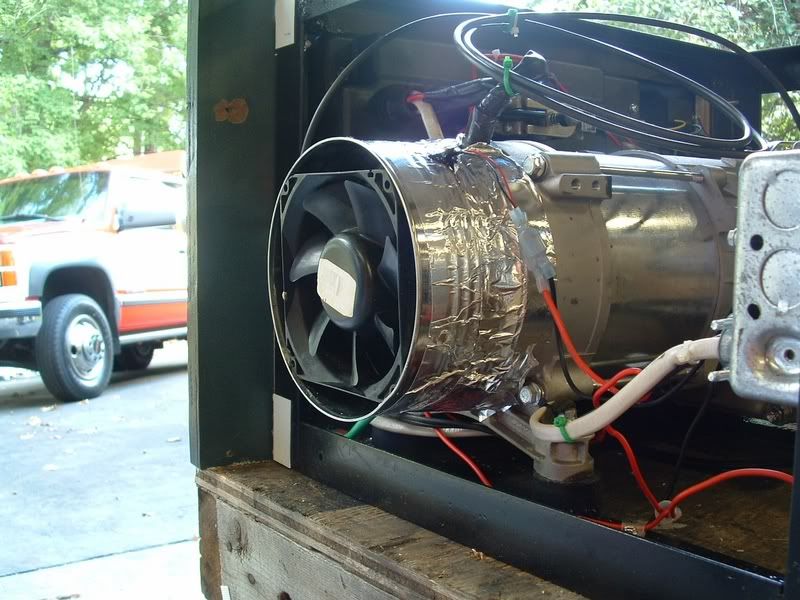
Also, the grill over the fan was on the outside of the enclosure.
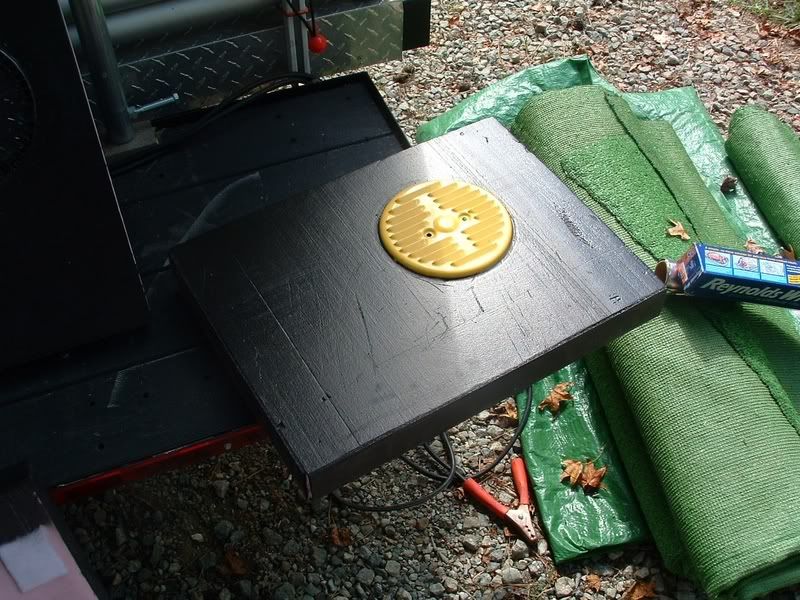
All of that "stuff" was to make sure that the business end of the genny got plenty of cool air and did not overheat.
There is a built in fan attached to the engine shaft inside the genny head that pulls some air through. Hot air blows out the bottom - right where the genny and engine bolt together. Unless you turned one upside down, you most likely would never notice this air exhaust point. It is also the point where a downdraft or sidedraft fan may be needed if the genny is in an enclosure.
Actually, a booster fan as I showed would be a good idea for a non-enclosed genny operating on a hot day with a high load. It might also prevent an AVR failure due to heat.
2009 Cedar Creek 5th Wheel - 2004 Volvo VNL670 class 8 MotorHome conversion as toter.
Turbocharged, 12L, 465 HP and 1,800 ft. Lbs. of torque.
- Mark as New
- Bookmark
- Subscribe
- Mute
- Subscribe to RSS Feed
- Permalink
- Report Inappropriate Content
Sep-08-2008 07:31 AM
Well at 74 I'm still learning. Hopefully. On the installation of my old DuroPower in the previously owned HM as you remember, I added about 36" of 3/4" pipe from the manifold to the muffler. This caused overheating in some way. Perhaps by back pressure? There were 3 90 degree elbows to the muffler. When you mentioned cooling, this came to mind. I noticed a reduction in output of power from the genny after this installation. So proper cooling is necessary to get max from the 200GX engine. Interesting.
Floyd
- Mark as New
- Bookmark
- Subscribe
- Mute
- Subscribe to RSS Feed
- Permalink
- Report Inappropriate Content
Sep-08-2008 06:58 AM
Old & Slow wrote:
Prof'
I know you just love me because of my questions. To bad you did not have the pleausure of me in your class. You might have tolds me in a PM~ need to know the answer or have knowledge of the question, first. 🙂 Now. I recieved a PM from one of the threaders who stated the Champion 120v only genhead had different windings than the 120/240v C46540. He had info' the 40008 was 3000/3500 and the C46540 was 3500/4000~ in other words the C46540 produces a higher output than the 40008. Is this why maybe the 40008 is not easy to locate? My old DuroPower DP3500EC was Electrice start and 120v/240v with a switch to tie the two winding together just like the C46540 ~ I think maybe red meat here.:h
Floyd
How does one expect to find answers if you don't ask questions?
Yes, there is a difference in the way the windings are physically constructed between CPEs 120 volt only units (Home Depot and 40008) and the dual voltage C46540. I cannot tell you exactly what the difference is because I have never un-wound one. The 120 volt only units do have less distortion on the output waveform - this I have tested and observed.
You know, when we draw or talk about these windings it makes one believe there is one winding on top (MW1) and another on the bottom (MW2) and the armature has two specific magnetic poles.
The truth is that is over simplification of the construction method. There are multiple windings in each that are interconnected around the entire circumference of the stator and rotor.
The stator and rotor (armature) both have a small amount of residual magnetism that is necessary to get the generation process started. This is why it is occasionally necessary to reflash the generator and exercise it on a regular basis when not being used.
As the armature spins in this small magnetic field it builds enough current to "self excite" the opposing field. Thus, we have an electromagnetic field rather than a permanent magnetic field as we show in most drawings.
The more conjoined windings we have in a mechanical generator, the truer the output wave will be to that desired "perfect, low distortion sine wave".
As for wattage of different units. Remember wattage is a measurement of power or how much work a generator can do. This is found by multiplying voltage x amperage. I don't give a gnats a*s about individual power ratings - most are advertising hype. For a Chinese genny with a 6.5 HP, 196 cc engine you can reliably expect 2,800 watts of energy on a continuing basis (23 amps at 120 volts or 11.5 amps at 240 volts). Higher current "may" be available on a surge, peak or during a specified time period - but not continuously.
Some mechanical Chinese generators "may" be built more efficiently and/or provide better cooling - thus you can squeeze a little more power out of them. But again, in the 3,000 watt Open Frame Mechanical Chinese Generator Class with the GX200 style engine, take the advertising of 4,000 watts with a grain of salt. It is not an operational rating.
Bottom line - the 500 watt difference between the 4,000 watt peak rating of the 40008 and the 3,500 watt rating of the C46540 is, IMHO, only on the outside of the box and attached labels.
Glad to know your arm is getting better.
2009 Cedar Creek 5th Wheel - 2004 Volvo VNL670 class 8 MotorHome conversion as toter.
Turbocharged, 12L, 465 HP and 1,800 ft. Lbs. of torque.
- Mark as New
- Bookmark
- Subscribe
- Mute
- Subscribe to RSS Feed
- Permalink
- Report Inappropriate Content
Sep-08-2008 04:52 AM
toprudder wrote:professor95 wrote:
This is the thingie I made for my ELM3000 several years ago. Both pigtails are parallel at the 30 amp TT outlet. This version has the caps physically tied together with a gear type hose clamp and glue, but that is not necessary.
I am glad to see that you did tie them together. IMHO, it is necessary to have them physically tied together, since there is a chance someone might try to plug them in while the generator is running. If they are physically tied together, they have to be plugged in together. If they are not tied together, when one is plugged in and the other is not, the one NOT plugged in is HOT and can short to the metal frame, or through the person trying to plug it in.
Bob,
I had a good he-ha with your post, on myself. I can be forgiven hopefully as I am (WGERORE11 used to say) no 'lectrian. Say, where is he, I miss him. Ok, here we go. One day I was making a attempt to wire my Champion with a 30a (cap) to the junction box used by the old ONAN I was replacing. I plugged the cap and the attached wire into the genset 30a receptacle (with wire attached) and layed that wire on top of the genset that had been placed in the factory genset compartment. I had been testing the direction and out flow of the air from the genset. Some question came to mind (bad) so I crancked up ol' genny. I pleaced my hand on top of the genny checking the air flow and that was a lucky day. I'm sure I only missed touching that live (hot) wire by a fraction of a inch. Guess it was not my time to go. Anyway, I fear a novice like myself doing all this wiring talked about. But I'm 74 so this has to be taken into account. So Bob, that hot wire story brought back the thought of a bad day in black rock. I would say, tie the two caps together, much safer.
Floyd
- Mark as New
- Bookmark
- Subscribe
- Mute
- Subscribe to RSS Feed
- Permalink
- Report Inappropriate Content
Sep-08-2008 04:18 AM
I know you just love me because of my questions. To bad you did not have the pleausure of me in your class. You might have tolds me in a PM~ need to know the answer or have knowledge of the question, first. 🙂 Now. I recieved a PM from one of the threaders who stated the Champion 120v only genhead had different windings than the 120/240v C46540. He had info' the 40008 was 3000/3500 and the C46540 was 3500/4000~ in other words the C46540 produces a higher output than the 40008. Is this why maybe the 40008 is not easy to locate? My old DuroPower DP3500EC was Electrice start and 120v/240v with a switch to tie the two winding together just like the C46540 ~ I think maybe red meat here.:h
Floyd
- Mark as New
- Bookmark
- Subscribe
- Mute
- Subscribe to RSS Feed
- Permalink
- Report Inappropriate Content
Sep-07-2008 09:05 PM
toprudder wrote:professor95 wrote:
This is the thingie I made for my ELM3000 several years ago. Both pigtails are parallel at the 30 amp TT outlet. This version has the caps physically tied together with a gear type hose clamp and glue, but that is not necessary.
I am glad to see that you did tie them together. IMHO, it is necessary to have them physically tied together, since there is a chance someone might try to plug them in while the generator is running. If they are physically tied together, they have to be plugged in together. If they are not tied together, when one is plugged in and the other is not, the one NOT plugged in is HOT and can short to the metal frame, or through the person trying to plug it in.
Yes - glad you noticed! But, if anyone did I would expect it to be you :). Also a point to be considered if one does NOT tie them together. PLUG THE ADAPTER INTO BOTH OUTLETS BEFORE YOU START THE GENERATOR.
2009 Cedar Creek 5th Wheel - 2004 Volvo VNL670 class 8 MotorHome conversion as toter.
Turbocharged, 12L, 465 HP and 1,800 ft. Lbs. of torque.
- Mark as New
- Bookmark
- Subscribe
- Mute
- Subscribe to RSS Feed
- Permalink
- Report Inappropriate Content
Sep-07-2008 08:54 PM
professor95 wrote:
This is the thingie I made for my ELM3000 several years ago. Both pigtails are parallel at the 30 amp TT outlet. This version has the caps physically tied together with a gear type hose clamp and glue, but that is not necessary.
I am glad to see that you did tie them together. IMHO, it is necessary to have them physically tied together, since there is a chance someone might try to plug them in while the generator is running. If they are physically tied together, they have to be plugged in together. If they are not tied together, when one is plugged in and the other is not, the one NOT plugged in is HOT and can short to the metal frame, or through the person trying to plug it in.
- Mark as New
- Bookmark
- Subscribe
- Mute
- Subscribe to RSS Feed
- Permalink
- Report Inappropriate Content
Sep-07-2008 08:52 PM
budracer1 wrote:
You guys may have to back track a day or 2 to refresh your memory but would this work on my generator if so professor could you instruct me on how to wire it?
thanks Jason
It may be time to do a little electricity 101 lesson.
First topic is phase relationships: Most all of these Chinese gennys have two main windings. Inside of these windings there is an armature.

In the drawing below we are spinning a wire coil inside a permanent magnet field. The wire is the armature. The stator or non moving part of our generators is similar to the permanent magnets in the drawing - except our generators use electromagnets. When the armature is in position "a" voltage and current will be at their peak - or the very top of a sine wave.
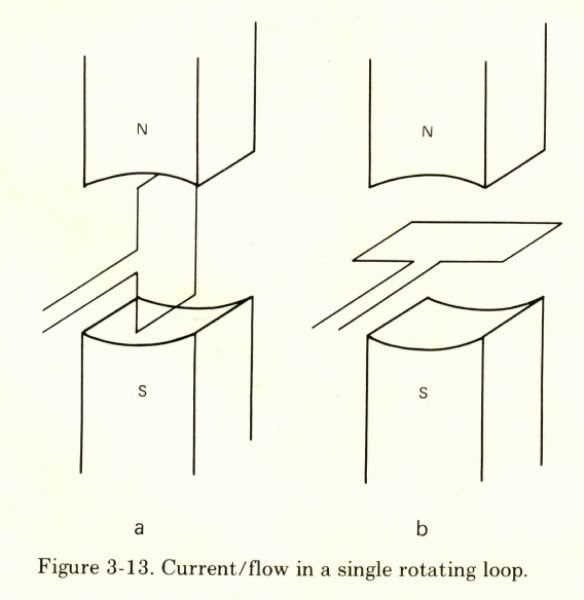
In the frame shot of a sine wave below, this point will be marked in red - it is the mountain" in the wave. We will refer to this as "zero degrees" in this example.
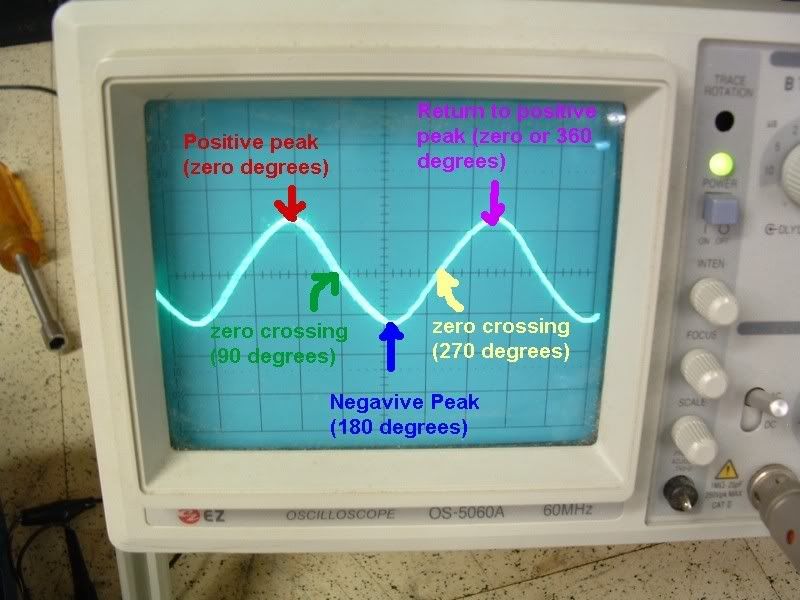
When the armature turns 90 degrees to position "b", there will be no current or voltage. This is the "center line" or "zero crossing point" in the photo shown in green. When the armature reaches 180 degrees the voltage and current will be equal to "a", but they will be flowing in opposite directions (which is why it is called alternating current). This is the "valley" going toward the bottom of the scope screen marked in blue. At 270 degrees there will once again be no current or voltage (yellow) and at 360 degrees (violet) we start all over again. (Oh, for those who want to see zero degrees start at a zero crossing point - I moved it up to coinside with the drawing. It is still 360 degrees no matter where we start as long as we have a full cycle or period.;))
Many Chinese generators put the two coils represented by the N and S magnets in the drawing in series, thus we receive 240 volts for each 360 degree revolution. To get 120 volts the coils are center tapped and while one 120 volt outlet is going positive the other is going negative. This is called a 180 degree phase differential.
If we take the top coil and the bottom coil and wire them in parallel so that there is no phase differential we have 120 VAC with the same useable wattage going to one outlet (or branch circuit) as we would at 240 volts.
A common practice on generators that offer both 240 and 120 VAC (without a selector switch) is to "split" the duplex outlets as shown below. In this example the left part of the duplex outlet will be going positive while the right part is going negative.

In generators that ONLY have 120 volt output or have a selector switch on the front panel for 120 or 240 VAC the duplex outlet(s) are not split. Thus both halves of the duplex outlet have the same phase relationship.

This is why using the "orange" adapter that ties two parts of a duplex outlet together to one 30 amp TT outlet can ONLY be done if both halves of the duplex outlet are receiving voltage and current with the same phase relationship.

So, why would we want to tie both parts of a duplex outlet together for one 30 amp TT outlet - why not just use a simple dogbone adapter?
The answer is heat - or the avoidance of heat in the outlet.
The photo below shows two outlets. One is rated for 20 amps, the other 15 amps. Visually the difference is the presence of the "T" slot on the neutral side of the outlet.
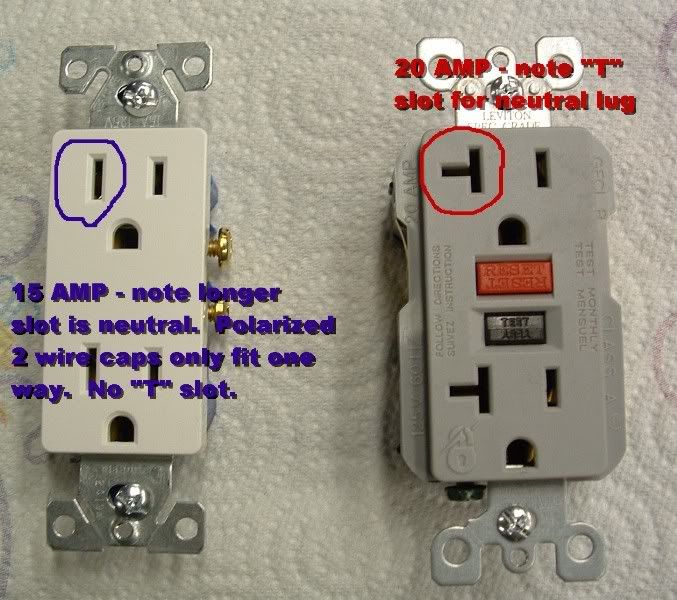
Inside the 20 amp outlet the brass contacts or wipers and buss bars will be larger. This is a photo of a 15 amp outlet opened up. Note the small surface area of the contact wiper. If this type of outlet were used with higher current, it would overheat due to resistance at the contact points.

“If” we use both halves of a 15 amp duplex outlet to feed a 30 amp TT outlet we will double the contact area and thus reduce the possibility of creating too much heat.
Ray (walkers2rad) made some excellent comments on the pros and cons of doubling a duplex outlet a few postings back. Ultimately, the circuit breaker protecting the outlet will determine the amount of current.
When I made the adapter shown below, I had two 15 amp breakers in parallel (30 amps total) on a ELM3000 protecting a single 20 amp duplex outlet. I did not want to use a 15 amp to 30 amp dogbone adapter due to possible heating at the contact points, thus I made the adapter shown. BTW, this was before I knew the orange one existed.
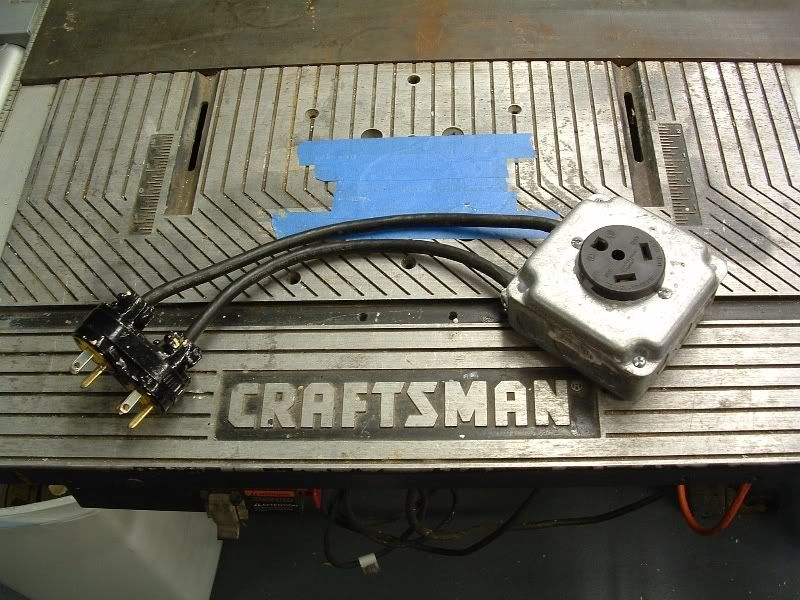
Ray (walkers2rad) would not be able to use the orange outlet since his inverter genny does not have a standard duplet. His genny has two single 120 volt outlets in a different orientation. He would need to make one of these to achieve the same benefits.
Jason wanted to know how the thing is wired so I made some more photos so that anyone who wants to undertake this project will not make something to hurt themselves or their generator.
To start a 4” square outlet box is needed. There will be “knockouts” in the box for Romex wire connectors. You will also need a 30 AMP TT outlet and a cover for the box with a hole that matches the TT outlet size.
You will also need two pieces of #14 or #12 SJ or SJO rubber jacket 3 wire cord about 16” to 24” long.
Lastly, two 120 volt caps (some call them plugs) with a rating of at least 15 amps each. Don’t buy cheap ones. The type shown here is a lot easier and safer to wire.
Put the caps on each piece of rubber cord as shown in the 3 photos below. Be absolutely sure to follow the color codes shown.


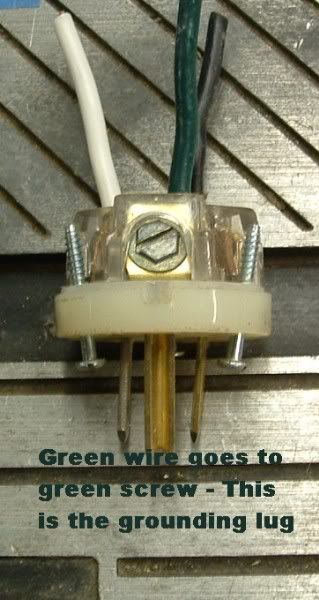
Put two 1/2" Romex connectors into the 1/2" knockouts in the 4” box. Note there may also be a 3/4" knockout. Leave it alone! Strip back the insulation on the rubber cord so you have no less than 6” or no more than 8” of wire in the box.
With the TT outlet positioned as shown (upside down Y) connect the white, black and green wires as shown.
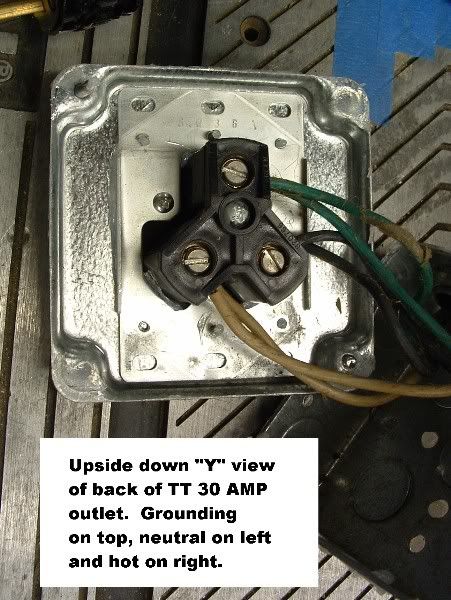
Tighten the Romex clamps and put the cover on the box. When looking at the outlet from the front, note which lug is neutral. It is shown by the white mark below.
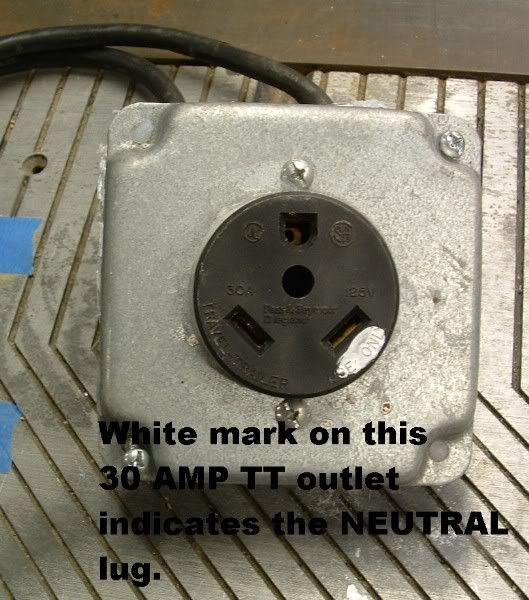
That should do it.
Edit Added:
As TopRudder pointed out after this was posted; it is safest to tie the two caps together as I did (using glue and a hose clamp) so both are plugged in to an outlet at the same time. If you plug separated caps individually into a running generator the unplugged cap will have "hot" blades exposed - BAD! So, if the caps are not tied together ALWAYS insert both of them into the genny first and then start the genny. Same is true for disconnecting, turn the genny off then disconnect. Do not let anyone who does NOT understand the directions or possible risk of electrocution use this adapter if the caps are not tied together.
2009 Cedar Creek 5th Wheel - 2004 Volvo VNL670 class 8 MotorHome conversion as toter.
Turbocharged, 12L, 465 HP and 1,800 ft. Lbs. of torque.
- Mark as New
- Bookmark
- Subscribe
- Mute
- Subscribe to RSS Feed
- Permalink
- Report Inappropriate Content
Sep-07-2008 10:49 AM
walkers2rad wrote:Old & Slow wrote:
Richheck,
I noticed the plug in a local RV store last week. I need that for my home shore power cord. Guess I'll have to return and buy one.
Floyd
Using that at home will not quite give the same benefit as it does from a gen but rather a possible sense of false security in thinking one can pull more from the outlet than they should. With that said I dont necessarily think those should be sold to the general public. It does make a better connection to the outlet but may move the place where things get hot to inside the outlet box where the potential for fire is greater.
Most houses are wired so that both plugs dont pull power from different circuts between the two outlets in the wall. In a gen they may be on seperate circuts. Sure if you pull your outlet out you may notice that it has two sets of wires to it but one is power coming in and the other is going to another outlet. Sure one could be wired with two different circuts with this in mind from the beginning but not likely. So you would be limited by whatever your outlet is wired with, 14 gauge wire and a 15 amp breaker is going to be just that using this or the adapter you probably allready have. If it is on a 20 amp breaker and you have 12 gauge wire and so on. Pulling 30 amps requires 10 gauge wire minimum... 8 if it is a long distance. So consider the distance from that outlet box to the breaker when trying to pull extra power because too much distance can create a dangerous condition with wires heating up.
The key is knowing what your actual loads are and your limits.
I agree with all the good info' you have taken the time to offer. At home I am not wired on the out side for proper 30a service. I have been using one adaptor to plug into one side of the 120v recepital. Just to power the converter/batt charger. So looking at the orange adp. seems to me to give a more secure connection. My feeling is most RV folks do not have the proper 30a service. For me, I'm looking for just a short time use of my MH or I would hire a 'lectrican and wire a 30/50a outlet. Thanks again for your contributions to this thread.





